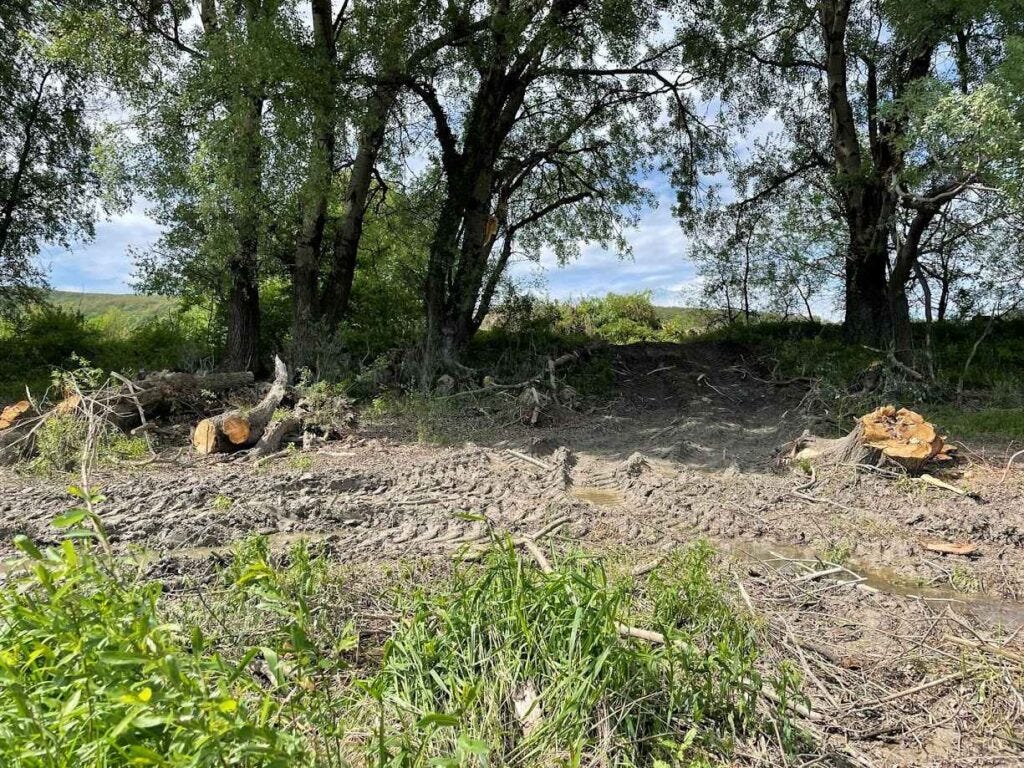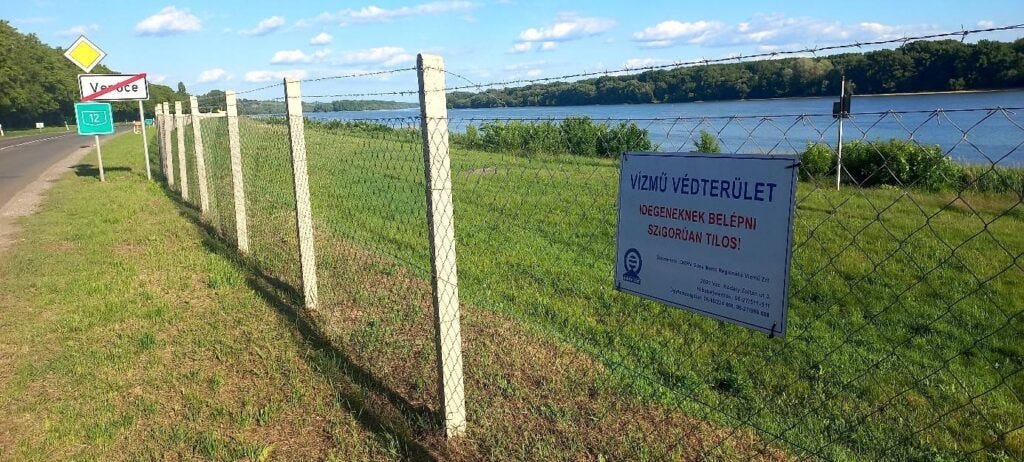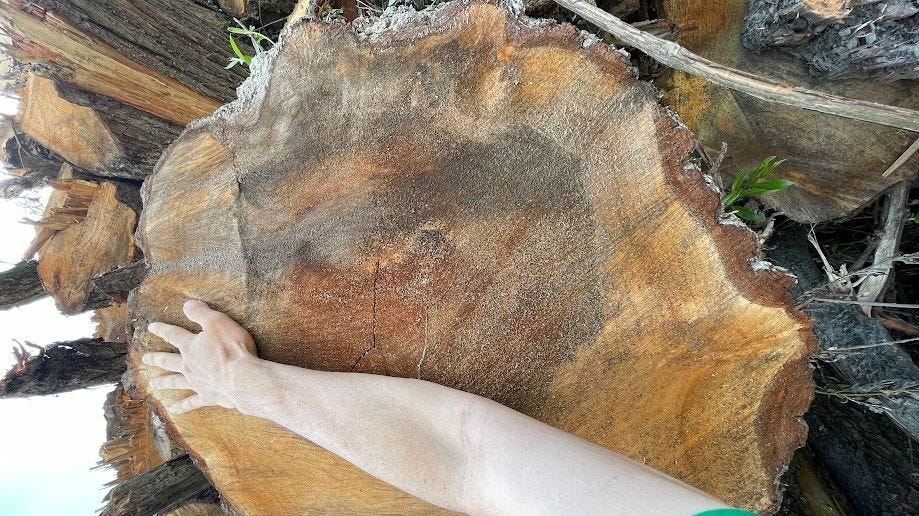My article below has recently been published on xforest.hu (in Hungarian) with the title Nagymarosi fairtás, avagy sivatagi folyó legyen-e a Duna (Forest Destruction in Nagymaros or Should the Danube Become a Desert River?)
A chainsaw was roaring. Giant trees, recently turned green, fell with a huge crash onto the beach. A metre-long dice snake took frightened shelter under the mass of broken branches. It felt like we were on another continent, in the Amazon jungle being clearcut. Yet the place was a domestic landscape: the bank of the Danube near Nagymaros, opposite Szentendre Island, part of the Danube Floodplain Special Conservation Area. Fifty metres away, a backhoe was stacking logs. From Highway 12 and the railway the only remaining tree line pleasantly covers the river, but from the shore the view was depressing. Hardly anything remained of the wide grove of trees hugging the Danube. Workers said the assignment was ordered by the water authority. They were to cut down trees leaning towards the riverbank, all along the waterworks protection area, from fence to fence. Yet completely straight trees were also falling, straight down onto the riverbank.
This remains of an once wide forest belt. Photo: Gémesi Gyula
The large-scale destruction in nesting time caused considerable outrage among the locals, to which the Danube Regional Waterworks (DMRV) issued a short press release on 25 April. Their response to the questions posed by Telex, an online journal, was published without comment in a May 1 article of Telex. This clever PR piece sends out a message of professionalism and the need to protect the water of the people. We all agree with that, too bad that DMRV’s defense has little relation to dreadful, everyday reality. It’s worth examining some of their claims creatively interpreting the facts. Emphasis mine:
“The ongoing riverbed maintenance works - i.e., tree cutting in the riverbed”
Interpreting an old, healthy, protected belt of native trees in a near-natural state as a ‘riverbed’ is rather peculiar. Rivers change their beds all the time, the Danube once meandered where the Tisza flows today. By the standards of the water company, would that also count as Danube riverbed? As Dr. Kriska György (ELTE University) writes in his Facebook post: “There were no trees in the riverbed, so they could not be cut down. What they did cut down were decades-old trees that had lined the banks of the river and never caused any siltation. They were, however, a real treasure trove of biodiversity in a Special Conservation Area of Priority Importance."
“followed by dredging without deepening the river — with the permission of the Water Management Directorate, with all necessary consent from relevant authorities — is performed with the utmost care, taking into account bird conservation.”
How is it possible to clear a gallery forest during the nesting season “with the utmost care, taking into account bird conservation”?
“Our goal is to restore the ecological state of the Danube basin in order to save the water supply of Nagymaros, thus guaranteeing a safe drinking water supply for the population of Nagymaros.”
Dr Kriska: “An ecological state cannot be restored as there is always some ecological state. If they mean a good ecological state, that cannot be achieved by deforestation and dredging. Of course, one can try to subjugate nature and resist natural flow processes by defying the established water flow conditions, but the end result will probably be the same as on Palotai Island in Újpest.”
Part of the devastated area from the north. Photo: Szász Márk
“the section affected by thinning concerns the in-stream area of the Nagymaros Aquifer in front of production wells No. 1, 2, 3, 4, 5, 6, 7, where rotten, leaning willows designated by the Danube Ipoly National Park have been removed.”
How can removing all trees in a wide strip be called “thinning”? There was no designation of any kind on the healthy willows, most of which were growing straight.
“DMRV ZRt. is committed to preserving the environment and the values of nature. For this reason, the dredging of the Danube riverbed has been carried out in cooperation with the staff of the Danube Ipoly National Park and the Central Danube Valley Water Management Directorate, in order to ensure that the works, which are unavoidable for the provision of drinking water, have the least possible impact on the ecological system of the water basin.”
The DMRV has also done clearcutting in their Verőce basin, which is difficult to call “least possible impact”. The area in question has been barren ever since, with some box elder (Acer negundo) seedlings taking root. According to invaziosfajok.hu (invasivespecies) “Box elder is a transformative invasive species, the most unfavorable classification from a conservation point of view. According to conservation managers, box elder is the 7th most dangerous invasive species in protected and Natura 2000 areas in Hungary.”
The place of the felled Verőce forest belt. Photo: the author.
In response to the outcry, the mayor of Nagymaros posted the felling permit on Facebook, which shows that it was issued in November 2024. If the DMRV was committed to “preserving the environment and the values of nature”, it would have done the clearing during the winter months. And all this concerns only the damage done to nature. An even more important question is whether the tree destruction and dredging will actually result in more or better quality water. Could it be that it will only make things worse in the long run? DMRV presents the necessity of tree felling as an unquestionable fact: “work that is unavoidable for the provision of drinking water”, “in order to save the Nagymaros aquifer guaranteeing a safe drinking water supply for the population of Nagymaros” (emphasis mine).
It’s possible that DMRV acted professionally. Just as it is possible that there are better, less destructive ways to ensure water yield. “Dredging reduces the efficiency of shore-filtered drinking water wells by thinning the filter bed,” writes Danube researcher Szávoszt-Vass Dániel, author of dunaiszigetek.blogspot.com (danubeislands). In the last century, especially under the so-called socialist regime, huge amounts of gravel were mined directly from the Danube, 22 million cubic metres between Nagymaros and Budapest alone. “In case anyone doesn’t understand why the Danube riverbed is in such a state on this stretch; all I can say is: that’s why,” says Szávoszt-Vass.
To a problem caused by an aggressive intervention into a living system would further aggressive intervention be the answer? Although the dam at Nagymaros was prevented by popular protest, the one in Dunacsúny (Cunovo, Slovakia) was finished and, together with the Austrian dam system, catches all water-filtering gravel from the mountains. The Danube has changed, as has our understanding of natural systems. Would the mechanistic approach of ‘the country of iron and steel’1, be the proper attitude of the 21st century? And should the public wake up to such a development at the sound of chainsaws? An intervention of this scale changes the Danube bank for decades, perhaps forever.
Annual rings. Photo: Szász Márk
It is well possible that DMRV is a prisoner of conditions originating from previous inappropriate interventions. They must also be understaffed, be under a lot of pressure, have extensive bureaucracy and so on, we understand, we live in Eastern Europe, too. Perhaps the situation might improve if the honorable authority were to see the local population, instead of a nuisance to be shaken off, as stakeholders, even a resource. The original inhabitants are sure to be proud of their landscape, and it’s nature that makes newcomers and holidaymakers move or come to the Danube Bend. In the hope of positive dialogue, Erdőszeretet Szövetség (Forest Love Alliance) has sent a letter to DMRV. “We respectfully request that our community, committed to the future of the region, be provided with credible, detailed and publicly available information on all activities, interventions and water quality changes that affect the condition of the wells, the aquifer and the floodplain,” the letter reads, going into great detail about the data requested and the cooperation sought.
The guise of professional management may also cover a very different reason behind the recent brutal forest destruction spree in Hungary. We cannot rule out the possibility that all that tireless work of enthusiastic citizens in our forests is not so much aimed at the public good than at lining their own pockets. Society needs to see, with financial details, which companies are involved in felling, in dredging, in the use of the timber harvested. A package law recently passed through the voting machine has weakened the legal position of forests in Hungary even further. This petition is one way to protest. You don’t even have to get out of your easy chair to sign it. Once you got the hang of it, here’s another petition against deforestation — and of course you can also join the efforts of the Forest Love Alliance. The more letters we send to DMRV and local mayors’ offices, in this case to Nagymaros, the less certain they will be that tree destruction is such a good solution.
One of the heaps of logs. Photo: Esztehás Emőke
We can also protect the Danube by the choices we make in our lives. Using canoes instead of motorboats, approaching the shore by bicycle instead of cars that chew up the undergrowth and compact the soil, not only the river, but also our bodies will be healthier. We can even become part of nature’s immune system through small, everyday actions.
In some places in Egypt, the desert is already touching the Nile. The banks of the largest Hungarian river are still mostly forested, but in the Danube Bend a staggering number of trees have been felled in the last decade or two, on both sides. More and more people move here, more and more come here for holidays, some driving their jeeps all the way down to the water. The pressure on nature is constantly increasing. Heat spells are becoming more and more frequent, precipitation is becoming more and more unpredictable. Fish spawning grounds have dwindled, reed beds have all but disappeared. Trees clean the air and water, trap dust, protect the shore, moderate temperature, provide habitat for animals — the Danube gallery forest is needed more than ever. These floodplain forests are all that protect the river from becoming a canal. The Danube trees are not the property of a bureaucratic organization, they are the assets and treasure of all of us, not as logs but in their natural state, in their place, standing proud on the riverbank. There are those trying to take possession of the banks where they grow, planning yacht marinas, glampings, stands with junk food and plastic cups, and the trees cannot defend themselves. The choice is between a dead, desert canal or a reborn, living river. If you prefer the latter, it’s time to stand up for our green brothers and sisters.
A slogan from the forced industrialization era of the terrror Rákosi regime in Hungary in the 1950s.






